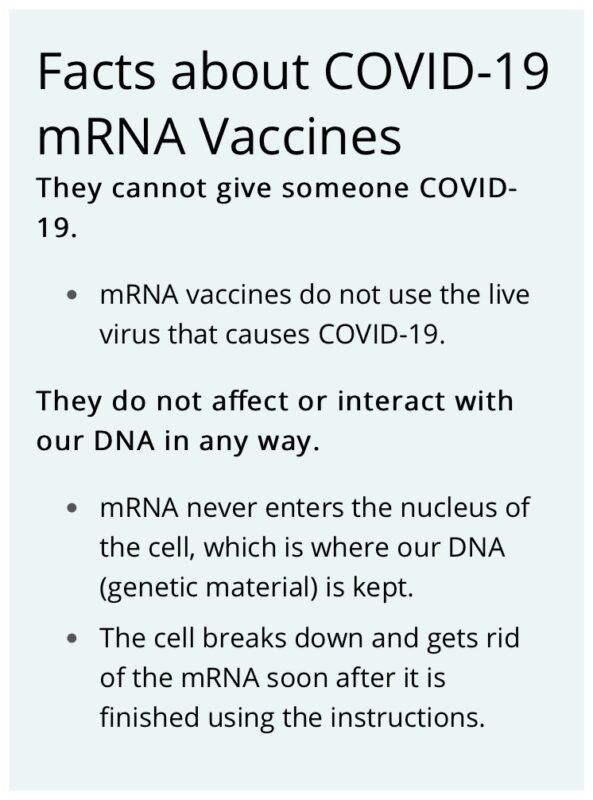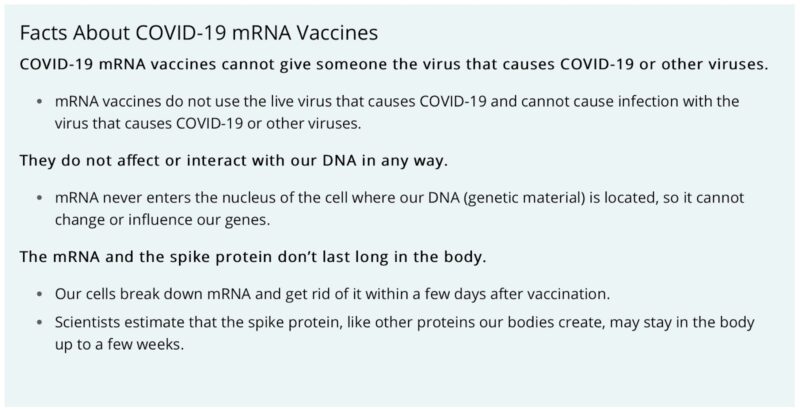On November 23, 2020, the Centers for Disease Control and Prevention (CDC) published information on something that was on everybody’s mind: vaccines against COVID-19.
In a page titled “Understanding mRNA COVID-19 Vaccines,” the CDC wanted everyone to know what to expect with the coming vaccines, which were being put forth under “Emergency Use Authorization” (EUA). The CDC linked to a page from the U.S. Food and Drug Administration (FDA) of November 20, 2020, to explain that EUA is “a mechanism to facilitate the availability and use of medical countermeasures, including vaccines, during public health emergencies, such as the current COVID-19 pandemic” and, under which, “FDA may allow the use of unapproved medical products, or unapproved uses of approved medical products in an emergency.” Specifically regarding the COVID-19 vaccines with EUA, the FDA and CDC assured everyone they would be “rigorously tested” and “rigorously evaluated for safety.”
Also, since the first vaccines to be rolled out would be messenger RNA (mRNA) vaccines, which are “a new type of vaccine” never before licensed for use in the U.S., the CDC wanted to explain to everyone how they would work. The CDC explained the difference in vaccine types this way:
To trigger an immune response, many vaccines put a weakened or inactivated germ into our bodies. Not mRNA vaccines. Instead, they teach our cells how to make a protein—or even just a piece of a protein—that triggers an immune response inside our bodies. That immune response, which produces antibodies, is what protects us from getting infected if the real virus enters our bodies.
It made sense for the CDC to issue such a page given that some people would naturally have questions about a new kind of vaccine. People understood traditional vaccines: The weakened or inactivated germ would not be strong enough to cause illness, while your body would recognize it as a threat and build up antibodies against it. Your immune system would remember it, and be able to fight it off should it someday encounter the real deal. It was a way of achieving the benefit of natural immunity without the obvious risk of natural infection. For this reason, vaccination is a medical miracle responsible for saving millions upon millions of lives.
With this new kind of vaccine, some people had concerns about teaching the body first to make a foreign protein, then to fight it off. It sounded like making the body wage war against itself, and also, such a vaccine has never been authorized before. Why do so now?
The CDC page explained that the new process for making vaccines had been known to researchers for decades, and that it allowed for rapid production of vaccines, something that, again, was certainly on people’s minds in late 2020 under COVID. In a section titled “mRNA Vaccines Are New, But Not Unknown,” the CDC explained that “researchers have been studying and working with them for decades” and that “they can be developed in a laboratory using readily available materials,” allowing for “faster” development than traditional vaccines. The CDC also wanted people to know that “Future mRNA vaccine technology may allow for one vaccine to provide protection for multiple diseases.”
The CDC also provided “A Closer Look at How COVID-19 mRNA Vaccines Work” to put people’s minds at ease about the new kind of vaccine (emphasis in original):
COVID-19 mRNA vaccines give instructions for our cells to make a harmless piece of what is called the “spike protein.” The spike protein is found on the surface of the virus that causes COVID-19.
COVID-19 mRNA vaccines are given in the upper arm muscle. Once the instructions (mRNA) are inside the muscle cells, the cells use them to make the protein piece. After the protein piece is made, the cell breaks down the instructions and gets rid of them. Next, the cell displays the protein piece on its surface. Our immune systems recognize that the protein doesn’t belong there and begin building an immune response and making antibodies, like what happens in natural infection against COVID-19.
At the end of the process, our bodies have learned how to protect against future infection.
From there we learned several things about the mRNA vaccines:
- They cause our cells to make a harmless protein that happens to be the “spike protein” used by the virus that causes COVID.
- This spike protein is harmless (the CDC emphasized that fact with bold text).
- The vaccine is injected in the upper arm muscle. Only the upper arm muscle cells (the cells near the injection site) make the harmless spike protein.
- An upper arm muscle cell makes only one harmless protein piece, then it breaks down the mRNA “instructions” and gets rid of them.
- The muscle cell displays the harmless protein piece.
- The immune system recognizes the harmless protein piece is unnatural and builds up antibodies to it.
- The immune system is now prepared to fight against an invasion by the real deal sporting that spike protein.
In a summary sidebar titled “Facts About COVID-19 mRNA Vaccines,” the CDC stated that “They cannot give someone COVID-19,” because they don’t use the “live virus.” The CDC also stated that “They do not affect or interact with our DNA in any way,” because they “never enter the nucleus of the cell” and because — importantly — “The cell breaks down and gets rid of the mRNA soon after it is finished using the instructions.”
Over the ensuing months, this page from the CDC would undergo many revisions. Only the most recent revision appears under the original page link. Previous versions are no longer available.
The only way to retrieve a past version is via the Internet Archive, something which — as I wrote on June 4, 2021 — had become a “go-to place for retrieving, as it were, previously published information … that became inconvenient post-vaccine and then virtually Memory-Holed.”
The CDC starts making some revisions
After a few slight revisions, the first big changes made to the CDC page occurred with the March 4, 2021 update, though strangely not right away. At some point the CDC added an opening section called “What You Need to Know.” It mostly highlighted the page’s main points, but even this section was changed many times without a new update date being given (see, e.g., May 1, July 1, and October 1). The last stealth revision added a new point in bold: “COVID-19 vaccines are not interchangeable. If you received a Pfizer-BioNTech or Moderna COVID-19 vaccine, you should get the same product for your second shot.”
At some point the CDC reorganized the “How COVID-19 mRNA Vaccines Work” section, making it even simpler and including a cartoon of a smiling person having received an injection but still wearing a mask. The image seemed to prefigure the coming counterintuitive vaccination message from the Biden administration, that the fully vaccinated must still wear masks, a reversal that thoroughly confused people who thought they understood vaccination.
The CDC also added a new, one-sentence sidebar under the section titled “COVID-19 mRNA Vaccines Will Be Rigorously Evaluated for Safety.” It presumed the answer by stating “mRNA vaccines are safe and effective.” A link under the phrase “safe and effective” took readers to the CDC’s December 13, 2020, page titled “Ensuring COVID-19 Vaccines Work.”
That page took a relatively comprehensive look at questions people might have had. Each of these questions was a section subhead:
- “Do clinical trial results show whether vaccines are effective?”
- “Why do experts continue to assess vaccine effectiveness in real-world conditions?”
- “How is the CDC coordinating with other U.S. government agencies to ensure COVID-19 vaccines work as expected?”
- “Will assessments determine if the vaccines protect people from severe COVID-19 illness?”
- “Will assessments provide information about how well vaccines protect against less severe COVID-19 illness?”
- “What groups of people will be included in the real-world vaccine assessments?”
This page has also undergone frequent revisions. The current page (as of June 29, 2022) contains only three bullet points. It tells people that “COVID-19 vaccines are safe and effective,” that vaccination “helps protect adults and children ages 6 months and older from getting severely ill,” and that some people “will still get sick” because “no vaccine is 100% effective.” It then follows with a brief apologia on vaccine effectiveness and breakthrough infections with links to cases, hospitalizations, and deaths by vaccination status. A cartoon one-child family is depicted bearing a “vaccine” shield despite being all masked. A disclaimer at the top of the page reads “CDC is reviewing this page to align with updated guidance.”
The CDC makes some bigger revisions
On October 18, 2021, the CDC issued an official update to the “Understanding mRNA COVID-19 Vaccines” page and again began revising it (see October 31). By that time, however, the CDC had already made jaw-dropping revisions to its longstanding definitions of “vaccine” and “vaccinated” and was in the midst of tweaking the definition of “fully vaccinated.” Of course, by this time Biden had announced his vaccine mandate, and many states and large employers had followed suit. People were losing jobs and being turned into social and civic pariahs for not submitting to the vaccines, despite their being a new form of vaccination and only under Emergency Use Authorization. Against all scientific reason and seemingly against any governmental and social or civic interests, such mandates were intended to protect, people with natural immunity to COVID were not spared the compulsion to be vaccinated.
In this revision, the CDC no longer put “COVID-19 vaccines are not interchangeable” in bold text, and it changed “you should get the same product for your second shot” to “you should get the same product when you need another shot” (emphasis added). This was the month in which CDC began to hedge on the total number of shots necessary to be considered “fully vaccinated.”
The “How mRNA Vaccines Work” section brought back language from its original page and added something: “Any temporary discomfort experienced after getting the vaccine is a natural part of the process and an indication that the vaccine is working.”
By far the biggest change, however, was to the “Facts About COVID-19 mRNA Vaccines” sidebar. The CDC added a third major heading of “Facts” elaborating on the very important point about the mRNA and spike protein being short-lived:
Before this update, readers may have thought the spike protein was as temporary as the mRNA. Here, however, they were told the spike protein may linger for a few weeks, a claim resting on scientists’ estimates.
In the next update (November 3, 2021), the CDC began promoting any booster in the “What You Need to Know” section: “The same COVID-19 mRNA vaccine product should be used for both doses of a two-dose primary series and for an additional primary dose, if needed. However, any of the COVID-19 vaccines can be used for a booster dose. The booster dose product does not need to match the product used for the primary series.”
The January 4, 2022, update made a bigger revision to that section, going all-in on the mRNA vaccines: “CDC recommends that people who are starting their vaccine series or getting a booster dose get either Pfizer-BioNTech or Moderna (mRNA COVID-19 vaccines). The mRNA vaccines are preferred over Johnson & Johnson’s Janssen COVID-19 vaccine in most circumstances, but the J&J/Janssen COVID-19 vaccine may be considered in some situations.”
Even bigger revisions in the latest updates
The next update wasn’t until June 16, 2022. It greatly truncated “What You Need to Know” to three things: mRNA vaccines teach our cells to make a protein to trigger an immune response, they benefit people like all vaccines, and researchers have been studying and working with them for decades. That was it.
This update made two changes to the “How mRNA Vaccines Work” section. It no longer used bold text to stress that the spike protein is “a harmless piece,” even though it had done that consistently from the very beginning.
A bigger change was made to the “Any temporary discomfort” sentence added in October 2021. Formerly that sentence read (emphasis added): “Any temporary discomfort experienced after getting the vaccine is a natural part of the process and an indication that the vaccine is working.”
The new sentence read (emphasis added): “Any side effects from getting the vaccine are normal signs the body is building protection.”
Readers were to adjust their expectation of natural/normal. Not “temporary discomfort” but “side effects,” and not a definitive “the vaccine is working” but a more vague “the body is building protection.”
Also, the previous ending, “Learn more about getting your vaccine,” was replaced with the following:
Use CDC’s COVID-19 booster tool to learn if and when you can get boosters to stay up to date with your COVID-19 vaccines. Staying up to date means getting all recommended COVID-19 vaccines including boosters when eligible.
People who are moderately or severely immunocompromised have specific COVID-19 vaccine recommendations, which include a third dose to complete their primary series, as well as two booster doses for those eligible.
That’s five shots in a year and a half.
As of this writing, the current update to the page contains the most shocking revisions to date. The July 15, 2022, update made a few other changes (such as adding that the injection could be made to the “upper thigh, depending on the age of who is getting vaccinated”; i.e., a very young child). But as noticed and written about by el gato malo, the CDC expurgated the entire third “Fact” about the short-lived nature of the mRNA and the spike protein.
Here is what the CDC removed from its “Facts”:
The mRNA and the spike protein do not last long in the body
- Our cells break down mRNA from these vaccines and get rid of it within a few days after vaccination.
- Scientists estimate that the spike protein, like other proteins our bodies create, may stay in the body up to a few weeks.
In short, our knowledge of the vaccines from the CDC has undergone great changes since November 2020:
- The CDC is no longer so confident that the protein our cells are caused to manufacture by the mRNA vaccines is harmless that they display it in bold text.
- The CDC no longer argues that our cells break down the mRNA soon after making the spike protein.
- The CDC no longer says the spike protein may stay in the body only for a few weeks.
The constant churn of revisions leaves us with many questions, when the whole point of producing a page entitled “Understanding mRNA COVID-19 Vaccines” was to prevent such a thing. They are, unfortunately, very big questions.
What does it mean if our cells don’t break down the mRNA and remove it soon? What does it mean if the spike protein they produce stays in the body much, much longer than we were originally told? Do they even know how long? What kind of lasting effects can vaccinated people expect? Are those effects exacerbated by boosting and continued boosting?
How prevalent are the effects? Do they differ for different people, and if so, by how much? Are those effects greater for small children? And are those effects at all related to the disturbing rise in non-COVID excess deaths in the U.K., Australia, and the U.S.?






